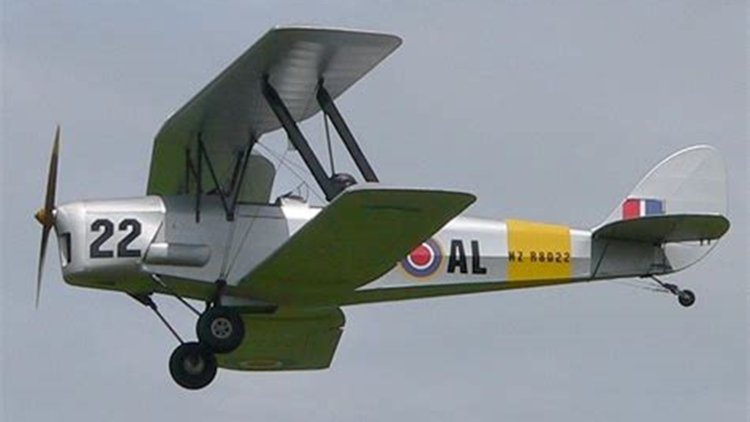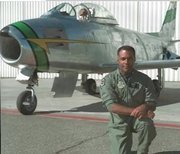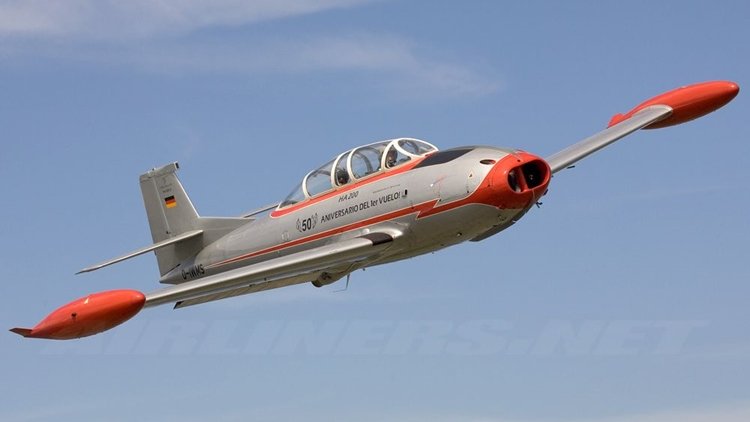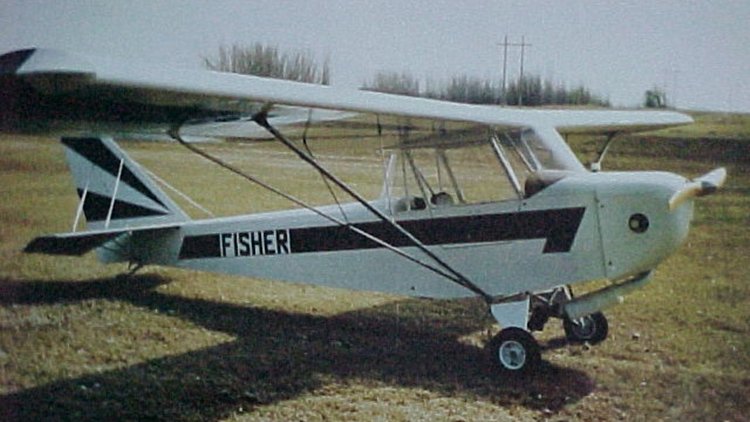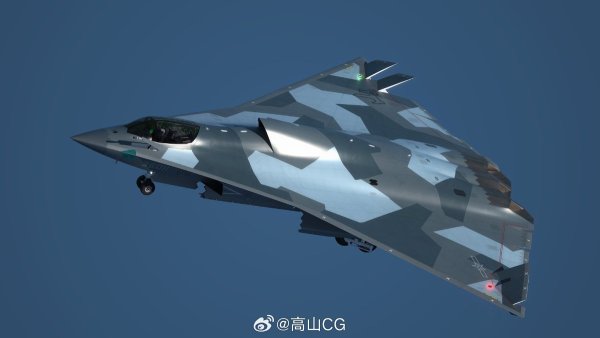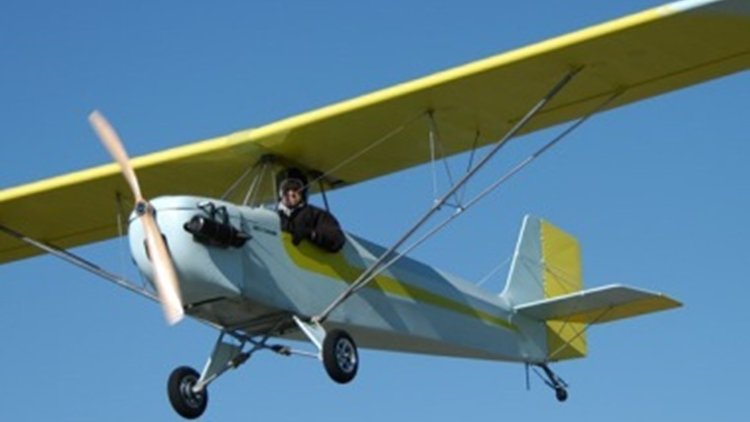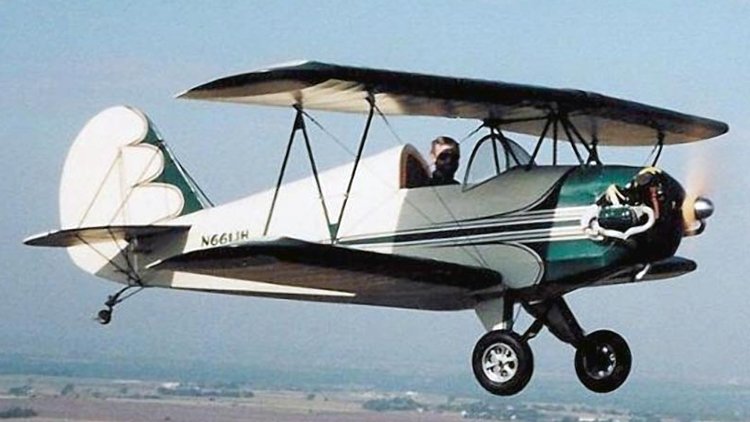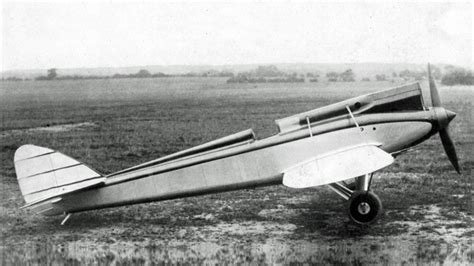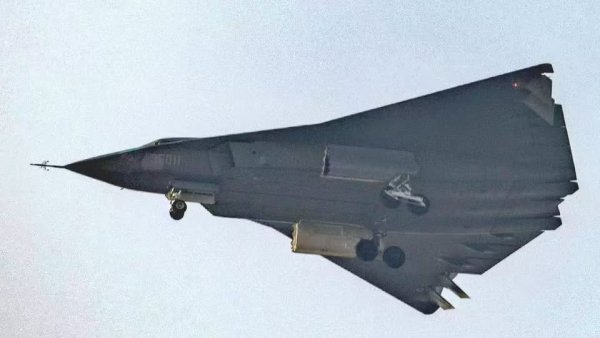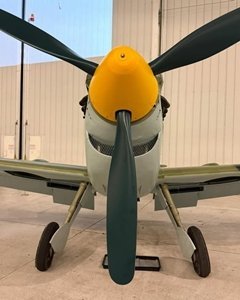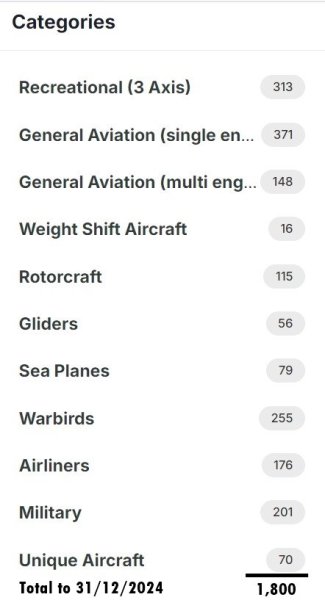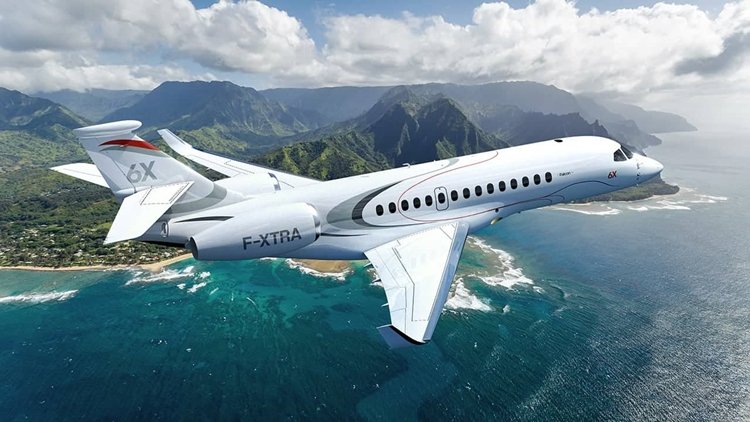-
Posts
7,556 -
Joined
-
Last visited
-
Days Won
67
Content Type
Profiles
Forums
Gallery
Downloads
Blogs
Events
Store
Aircraft
Resources
Tutorials
Articles
Classifieds
Movies
Books
Community Map
Quizzes
Videos Directory
Everything posted by red750
-
The Fisher R-80 Tiger Moth is a Canadian two-seat, conventional landing gear, single engined, biplane kit aircraft designed for construction by amateur builders. The designation indicates that the aircraft is 80% the size of the aircraft that inspired it, the de Havilland Tiger Moth. Fisher Flying Products was originally based in Edgeley, North Dakota, USA but the company is now located in Woodbridge, Ontario, Canada. The R-80 was designed by Fisher Aircraft in the United States in 1994 and was intended to comply with the US Experimental - Amateur-built category, although it qualifies as an ultralight aircraft in some countries, such as Canada. It also qualifies as a US Experimental Light Sport Aircraft. The R-80's standard empty weight is 560 lb (254 kg) when equipped with a 100 hp (75 kW) Norton AE 100R engine and it has a gross weight of 1,150 lb (522 kg). The construction of the R-80 is of wood, with the wings, tail and fuselage covered with doped aircraft fabric. The aircraft features interplane struts and cabane struts. Like the original Tiger Moth, the R-80 has no flaps. The R-80's main landing gear is bungee suspended. Cockpit access is via the lower wing. The company claims an amateur builder would need 600 hours to build the R-80. Specified engines for the R-80 version have included the 80 hp (60 kW) Geo Tracker auto-conversion engine and the 100 hp (75 kW) Norton AE 100R rotary engine. By late 2011 more than 24 R-80s were flying. In 2000 Fisher introduced a welded 4130 steel tube fuselage as an alternative to the standard wooden fuselage. This version featured a LOM M132 engine of 120 hp (89 kW), a gross weight of 1,350 lb (612 kg) and was developed at the request of customers. The steel fuselage version was known as the RS-80. Six RS-80s had been completed by the end of 2004. Since the company moved to Canada, the RS-80 option is no longer available. In reviewing the R-80 Ben Millspaugh wrote in Kitplanes Magazine: She flies beautifully. Ground handling is exceptionally easy and I'd recommend this airplane to anyone who is a first-time builder or any pilot with little or no tail dragger time. Variants R-80 Original version with wooden fuselage RS-80 Version with welded 4130 steel tube fuselage, introduced in 2000 and discontinued 2008.
-
An interesting aside on this aircraft. The American actor Michael Dorn, who played Leiutenant Worf on Startrek Next Generation and Startrek Deep Space Nine, was an airforce pilot and has owned a number of ex-miliary jets including the F86 Sabre and one of these aircraft. For more on Michael Dorns aviation connection, click here.
-
The Hispano HA-200 Saeta (English: Arrow) is a twin-seat jet advanced trainer designed and produced by Spanish aircraft manufacturer Hispano Aviación. It has the distinction of being the first Spanish aircraft to harness jet propulsion. The German aircraft designer Willy Messerschmitt can be largely credited for his role in designing the HA-200, which reused a substantial portion of the earlier piston-powered HA-100 Triana. On 12 August 1955, the first prototype conducted its maiden flight. It was not until 1962 that the first production aircraft performed its first flight. That same year, deliveries of the trainer aircraft commenced to the Spanish Air Force. It would be used in this capacity by the service for multiple decades. The HA-200 was later further developed into the Hispano Aviación Ha-220 "Super Saeta", which functioned as a dedicated ground attack platform, armed with rockets, bombs, and other munitions. The HA-220 served in the Spanish Air Force throughout the 1970s, seeing action during the Polisario uprisings against insurgents. The HA-200 was also exported, the type being produced under license by Egypt, where it was designated as the Helwan HA-200B Al-Kahira. During the 1980s, the more capable CASA C-101 was introduced to Spanish service, supplementing and eventually succeeding the older HA-200 in both trainer and light attack roles. The HA-200 Saeta is a jet-powered trainer aircraft. In terms of its configuration, it is a low-winged monoplane, featuring all-metal construction and a retractable tricycle undercarriage arrangement. Structurally, it was relatively conventional for the era, using semi-monocoque lightweight alloy construction. The cockpit of the HA-200 accommodated a crew of two in a tandem seating configuration; however, the ground-attack orientated HA-220 was furnished with a single-seat cockpit instead. For greater crew comfort, this cockpit was pressurised, the HA-200 being the first Spanish aircraft to possess this facility. The HA-200's propulsion consisted of a pair of Turbomeca Marboré turbojet engines, which were installed in a side-by-side arrangement inside the forward fuselage and mounted on a stressed-skin structure that forms the outer surface of the fuselage's underside. Air was fed to the engines via a large intake on the front of the nose; this particular intake arrangement has been described as being unique amongst jet aircraft. The engine's exhaust nozzles were located upon the lower fuselage, just aft of the trailing edge of the wing. A maximum of 261 gallons of fuel could be carried across a pair of fuselage tanks, two wing tanks and two permanently-attached tip tanks; provisions were made for jettisoning fuel in emergency situations. For weapons training purposes, the HA-200 featured provisions for the carriage of armaments. For more details of development, operational history and 10 varients, click here.
-
The Fisher FP-606 Sky Baby is a Canadian single-seat, conventional landing gear or tricycle landing gear-equipped, single-engined, high-wing monoplane kit aircraft designed for construction by amateur builders. Fisher Flying Products was originally based in Edgeley, North Dakota, United States, but the company is now located in Woodbridge, Ontario, Canada. The FP-606 was designed by Fisher Aircraft in the United States in 1986 and was intended to comply with the US FAR 103 Ultralight Vehicles category, with the category's maximum 254 lb (115 kg) empty weight. The 606's standard empty weight is 250 lb (113 kg) when equipped with a two-stroke 25 hp (19 kW) Hirth F-33 engine. The design goal was to provide an ultralight version of the Cessna 150 or Cessna 152, including its looks, styling features and docile handling. To this end the 606 incorporates the 150's Omni-Vision style rear window and the swept fin found on post-1965 Cessna 150s.[3][5][6] The wings are the same design as the Fisher FP-202 Koala with modified wingtips. The construction of the FP-606 is of wood, with the fuselage built from wood strips arranged in a geodesic form, resulting in a very strong and light aircraft with redundant load paths. The wings, tail and fuselage are covered with doped aircraft fabric. Like the Cessna 150, the 606's wings are strut-braced, but where the 150 uses a single strut, the FP-606 incorporates a "V" strut with "N" jury struts. Also unlike the 150, which has large and powerful flaps, the 606 has no flaps. The FP-606 can be fitted with either conventional-configuration (taildragger) or tricycle-style landing gear, which is bungee suspended in either configuration. The FP-606 has a single door for pilot access, that can be removed for flight. The company claims an amateur builder would need 500 hours to build the FP-606. The US FAR 103 Ultralight Vehicle category version of the FP-606 requires a light weight powerplant, such as the originally specified, but now out-of-production 28 hp (21 kW) Rotax 277 or the current 25 hp (19 kW) Hirth F-33. Amateur-built category versions can be powered by the 40 hp (30 kW) Rotax 447 or 50 hp (37 kW) Rotax 503 engines. The FP-606 won the Experimental Aircraft Association's Best New Design Award for light planes in 1988. By late 2011 more than 15 FP-606s were flying.
-

The news tonight - amazing! (NOT!)
red750 replied to flying dog's topic in AUS/NZ General Discussion
-
The I.P.D BF-1 Beija-Flôr (English: Humming Bird) was a two-seat light helicopter designed by Henrich Focke. The BF-1 was built by the aircraft department of the Brazilian Research and Development Institute Instituto de Pesquisa e Desenvolvimento (IPD) (formerly the CTA - Centro Técnico Aeroespacial), using a design of Henrich Focke. It was a conventional three-bladed single rotor helicopter, powered by a 225 hp (168 kW) Continental E225 piston engine, mounted in the nose. The tail unit included a small vertical dorsal fin with a horizontal stabilizer on the starboard side. Two inter-meshing tail rotors, each inclined at 45°, provided pitch and yaw control. Three prototypes were built, the first flying on 1 January 1959, but the type did not enter production.
-
The Fisher FP-505 Skeeter is a Canadian single-seat, conventional landing gear, single-engined parasol-wing monoplane kit aircraft designed for construction by amateur builders. Fisher Flying Products was originally based in Edgeley, North Dakota, USA but the company is now located in Woodbridge, Ontario, Canada. The FP-505 was designed by Fisher Aircraft in the United States in 1984 and was intended to comply with the US FAR 103 Ultralight Vehicles category, with the category's maximum 254 lb (115 kg) empty weight. The 505's standard empty weight is 245 lb (111 kg) when equipped with a two-stroke 28 hp (21 kW) Rotax 277 engine. The design goal was to provide a nostalgic 1930s-style parasol similar in configuration to the Pietenpol Air Camper or Heath Parasol that would be easy to fly, with a high wing and an open cockpit. The construction of the FP-505 is of wood, with the fuselage built from wood strips arranged in a geodesic form, resulting in a very strong and light aircraft with redundant load paths. The wings, tail and fuselage are covered with doped aircraft fabric. The wings are strut-braced with both jury struts and cabane struts. The aircraft has no flaps. The conventional-configuration landing gear is bungee suspended. The company claims it takes an amateur builder 500 hours to build the FP-505. Early versions of the FP-505 were equipped with the 28 hp (21 kW) Rotax 277, and the aircraft reportedly flies well on that minimum power. Since the Rotax 277 is no longer in production, the 25 hp (19 kW) Hirth F-33 is specified along with the 40 hp (30 kW) Rotax 447 and 50 hp (37 kW) Rotax 503 engines. By late 2011 over 45 FP-505s were flying.
-
The Fisher Youngster is a Canadian single-seat, conventional landing gear, single-engined, biplane kit aircraft designed for construction by amateur builders. The aircraft was inspired by the German Bücker Bü 133 Jungmeister aerobatic aircraft of the 1930s. Fisher Flying Products was originally based in Edgeley, North Dakota, USA but the company is now located in Vaughan, Ontario, Canada. The Youngster was designed by Fisher Aircraft in the United States in 1994 and was intended to comply with the US Experimental - Amateur-built category, although it qualifies as an ultralight aircraft in some countries, such as Canada. It also qualifies as a US Experimental Light Sport Aircraft. The Youngster's standard empty weight is 400 lb (181 kg) when equipped with a 50 hp (37 kW) Rotax 503 engine and it has a gross weight of 650 lb (295 kg). The aircraft is stressed for +6 and -3.75 g and is suitable for sportsman category aerobatics. The construction of the Youngster is of wood with the fuselage built in a Warren Truss covered with a 1⁄8 in (3 mm) birch plywood skin. The fuselage employs longitudinal stringers to replicate the Jungmeister's shape. The wings and tail are covered with doped aircraft fabric. The wings feature interplane struts, cabane struts, bottom wing ailerons only and a NACA 2315 airfoil. Like the original Jungmeister upon which it is based, the Youngster has no flaps. The Youngster's main landing gear has bungee suspension. The cockpit can be left open or covered with an optional canopy for cold weather operations. The company claims an amateur builder can complete the aircraft from the kit in 500 hours. The specified engines for the Youngster include the 50 hp (37 kW) Rotax 503 two-stroke and the Great Plains Aircraft 65 hp (48 kW) four-stroke Volkswagen air-cooled engine. Subaru auto conversions of up to 85 hp (63 kW) and 160 lb (73 kg) can also be used. By late 2004 20 Youngsters were flying. Variants Youngster Original Rotax-powered design Youngster V Great Plains Volkswagen air-cooled engine 65 hp (48 kW) powered version
-
The Fisher Super Koala is a two-seat, high wing, conventional landing gear, single-engined, light kit aircraft designed for construction by amateur builders. The aircraft was inspired by the design of the Piper J-3 Cub and strongly resembles that design. It can also be built wuth tricycle landing gear or floats. Fisher Flying Products was originally based in Edgeley, North Dakota, United States but the company is now located in Dorchester, Ontario, Canada. The Super Koala was designed by Fisher Aircraft in the United States and was first flown in 1983. It has two seats in side-by-side configuration. With its 400 lb (181 kg) empty weight and 830 lb (376 kg) maximum gross weight, the Super Koala was intended for the US homebuilt aircraft category. The construction of the Super Koala is unusual for aircraft in its class. The aircraft's structure is entirely made from wood, with the wooden fuselage built from wood strips arranged in a geodesic form, resulting in a very strong and light aircraft with redundant load paths. Like the Cub, both the wings and fuselage on the Super Koala are covered with doped aircraft fabric. The wings are strut-braced and utilize jury struts. The landing gear is bungee suspended and the tail wheel is steerable. The Super Koala has flaps, with brakes optional. The company claims it takes an average amateur builder 500 hours to construct a Super Koala. Engine options are the 50 hp (37 kW) Rotax 503 and the 64 hp (48 kW) Rotax 582 engine. With the Rotax 503 the gross weight is 740 lb (336 kg) and with the Rotax 582 is 830 lb (376 kg).
-

Another airliner crash - South Korea
red750 replied to red750's topic in Aircraft Incidents and Accidents
Jeju Air flight 2216 flew 13 times in just 48 hours and had previously been damaged in a runway accident before it was involved in one of the deadliest crashes in South Korean history, it has been revealed. The Boeing B737-800 crash-landed on its belly before skidding off the runway and smashing into a concrete wall, erupting in a fireball and killing all but two of the 181 people on board. The plane is believed to have experienced a landing gear malfunction during its descent towards Muan International Airport, 180 miles south of Seoul, after taking off from Bangkok on Sunday. Airline bosses insisted that the plane had 'absolutely no history' of accidents or maintenance issues, but it has emerged today that the tail of the plane collided with the runway almost four years ago. Described as a 'tail skid', the incident on February 17, 2021, saw a bumper attached to the rear of the plane's fuselage scrape along the runway during takeoff from Gimpo Airport. South Korea's Ministry of Land, Infrastructure and Transport reportedly imposed a fine of 220 million won (more than £100,000) on Jeju Air at the time, stating: 'It is a violation of safety regulations to fly without properly checking for damage to a part of the plane.' Minister Park Yong-gap today raised concerns that the incident was covered up, saying: 'The plane involved in this recent accident also crashed during takeoff three years ago... Jeju Air claims that there is no history of accidents at all. Isn't that a false explanation?' Jeju Air said in a statement that it had classified the collision as a 'non-accident' under aviation law as the damage to the plane was not significant, defending its earlier claim that the plane had no accident history. 'We have paid the full amount of the fine and completed all inspections and maintenance, and are now operating normally,' the airline said in a statement. It comes as industry experts have reportedly raised concerns that Jeju Air may have overused the plane in question in the days before the crash, scheduling excessive charter flights to meet the demand of the peak end-of-year season. Flight records cited by Yonhap news agency show that in the two days before the disaster, the jet traveled between Muan, Jeju Island and Incheon, as well as international destinations including Beijing , Bangkok, Kota Kinabalu, Nagasaki and Taipei. Data also shows that Jeju Air had the highest average monthly flight time among the six domestic low-cost airlines in South Korea , between July and September this year, according to Korean media. Jeju Air also paid the largest amount of fines between 2019 and August of this year, JoongAng reports. Regional airports in South Korea are often reliant on charter planes operated by low-cost carriers such as Jeju Air, with travel agencies filling the jets with their passengers during the holiday seasons. It was the first fatal flight for Jeju Air, a budget airline founded in 2005 that ranks behind Korean Air Lines and Asiana Airlines as the country's third largest carrier by passenger numbers. A total of 101 aircraft, operated by six airlines using the same model as the plane that crashed on Sunday, will be 'thoroughly reviewed', Joo said, adding that the inspections would last until January 3. Sunday's crash was the worst for any South Korean airline since a 1997 Korean Air crash in Guam that killed more than 200 people, transportation ministry data showed. Devastated family members of the victims have been demanding answers from the authorities. Jeon Je-young, whose daughter Mi-sook was one of 179 who died on board Jeju Airlines flight 2216, says he still cannot believe what happened. 'When I saw the accident video, the plane seemed out of control,' the 71-year-old father said. Video of the plane's approach show it hitting a bird, before it circled the runway and attempted to land with its flaps up. Experts believe this suggests the aircraft suffered hydraulic failure, which could have also prevented the landing gear from deploying. Leading air safety expert David Learmount told Sky News that having a concrete wall at the end of the runway was 'verging on criminal' and said the collision with the object was the 'defining moment' of the disaster. He suggested that had the wall not been there, the plane would have instead hit a fence, slid over a road and likely stopped in a nearby field. However, Tim Davies, an ex-RAF Tornado fighter pilot, was skeptical this was the sole cause of the tragedy and feared 'pilot error' may have contributed to the disaster. -

Another airliner crash - South Korea
red750 replied to red750's topic in Aircraft Incidents and Accidents
CNN. An Air Canada Express flight “experienced a suspected landing gear issue” after arriving at Halifax Stanfield International Airport in Nova Scotia on Saturday night, though no injuries were reported, according to the airline. Flight AC2259 – which took off from St. John’s, Newfoundland – was subsequently “unable to reach the terminal and customers were offloaded using a bus,” Air Canada spokesperson Peter Fitzpatrick said in a statement to CNN. The flight, operated by partner PAL Airlines, was carrying 73 passengers, the statement said. The plane – a De Havilland DHC-8-402, according to the Transportation Safety Board of Canada – skidded down the runway for a “decent” distance, and passengers saw flames on the aircraft’s left side, passenger Nikki Valentine told CNN newsgathering partner CBC. “The plane shook quite a bit and we started seeing fire on the left side of the plane and smoke started coming in the windows,” Valentine said. -

Another airliner crash - South Korea
red750 replied to red750's topic in Aircraft Incidents and Accidents
A Jeju Air flight has been forced to turn around after experiencing landing gear issues just a day after South Korea's deadliest airline disaster in decades. This morning, another Jeju Air flight departed Seoul's Gimpo International Airport for Jeju island, but was forced to turn around after a landing gear issue was detected shortly after takeoff, the South Korean airline said. 'Shortly after takeoff, a signal indicating a landing gear issue was detected on the aircraft's monitoring system,' Song Kyung-hoon, head of the management support office at Jeju Air, told a news conference. 'At 6.57 am, the captain communicated with ground control, and after taking additional measures, the landing gear returned to normal operation. 'However, the decision was made to return to the airport for a thorough inspection of the aircraft.' Local media reported that 21 passengers chose not to board an alternate flight to Jeju, citing concerns over safety and other reasons. The airline has seen a surge in customers cancelling their flight reservations since Sunday's incident, with a total of 68,000 tickets cancelled, Yonhap news agency reports. Jeju Air's 41 plane fleet includes 39 Boeing 737-800 aircraft. -

Another airliner crash - South Korea
red750 replied to red750's topic in Aircraft Incidents and Accidents
The heartbreaking last words of a passenger on the doomed Jeju Air flight that crashed, so far killing 179, have been revealed. Jeju Air flight 7C2216, arriving from the Thai capital Bangkok with 181 people on board, was attempting to land shortly after 9 a.m. (0000 GMT) at South Korea's Muan International Airport when it veered off the runway and erupted in a fireball as it slammed into a wall. A passenger texted a relative to say a bird was stuck in the wing of the plane, the News1 agency reported. The person's final message was, 'Should I say my last words?' The crash is the worst by any South Korean airline since a 1997 Korean Air crash in Guam that killed more than 200 people, according to transportation ministry data. The twin-engine Boeing 737-800 can be seen in video from local media skidding down the runway with no apparent landing gear before slamming into a wall in an explosion of flame and debris. Other photos showed smoke and fire engulfing parts of the plane. -
Have done a few times.
-

Another airliner crash - South Korea
red750 replied to red750's topic in Aircraft Incidents and Accidents
An updated report... https://au.yahoo.com/news/passengers-being-rescued-plane-crashed-005000634.html -
At least 29 are dead after a plane carrying 181 people crashed off a runway and smashed into a wall at a South Korean airport. For reporrt with video, followed by other accident clips, click here.
-
Onetrack is correct. When I first saw the name, I thought is was wrong, because we all know a Tiger Moth is a biplane, but de Havilland built two different Tiger Moths.
-

The news tonight - amazing! (NOT!)
red750 replied to flying dog's topic in AUS/NZ General Discussion
-

E-190 was shot down Xmas day 2024
red750 replied to pmccarthy's topic in Aircraft Incidents and Accidents
Here is an article claiming Russia refused permission for the airliner to land, to force it to ditch in the sea. Russia tried to make plane crash in sea -

The news tonight - amazing! (NOT!)
red750 replied to flying dog's topic in AUS/NZ General Discussion
Here is an MSN article with slideshow which gives a background on the Chinese superplane. Chinese super weapon. -
The Dassault Falcon 6X is a large, long-range business jet developed by Dassault Aviation in France. Its precursor, the Falcon 5X twinjet, was launched in 2013, rolled-out in 2015 and made its first flight on July 5, 2017, but its development was frozen as its Safran Silvercrest engine failed to meet performance objectives. In December 2017, the Falcon 6X was launched as a stretched version with PW812D turbofans, made its first flight on 10 March 2021, and entered service on 30 November 2023. It has the widest purpose-built business jet cabin at 2.58 m (102 in). Its 70.7 m2 (761 sq ft) wing allows a 35,135 kg (77,459 lb) maximum weight with 59.9 kN (13,460 lbf) engines, for a 5,500 nmi (10,200 km) range and a Mach 0.90 top speed. The Falcon 6X is largely based on the Falcon 5X aerodynamics and systems, validated during its preliminary flight test program, but it is optimized to take advantage of its 58–62 kN (13,000–14,000 lbf) PW812D engines for a longer cabin and a greater 5,500 nmi (10,200 km) range, a Mach 0.90 top speed and a Mach 0.85 cruise. Its cabin is 12.3 m (40 ft) long, is 1.98 m (78 in) high by 2.58 m (102 in) wide (the largest in a purpose-built business jet), and can accommodate 16 passengers in three zones with 29 windows, including a galley skylight. A front-fuselage extension makes its cabin 51 cm (20 in) longer.[30] The Falcon 6X reinforces the 5X new 70.7 m2 (761 sq ft) wing and keeps its digital flight control system and Honeywell Primus Epic EASy III flight deck. The new engine fans have a diameter of 110 cm (44 in), 15 cm (6 in) narrower than the Gulfstreams, with four low-pressure turbine stages instead of five, engine weight is reduced by 91 kg (200 lb). Its empty weight increases by 1,030 kg (2,270 lb) or 5.7%, from 18.1 to 19.2 t (40,000 to 42,300 lb), due to heavier engines, fuel system and structural reinforcements.[31] The Falcon 6X will be the first Dassault aircraft with a nitrogen inerting system.
-
The Cessna 190 and 195 Businessliner are a family of light single radial engine powered, conventional landing gear equipped, general aviation aircraft which were manufactured by Cessna between 1947 and 1954. The 195 model was also used by the United States Air Force, United States Army, and Army National Guard as a light transport and utility aircraft under the designations LC-126/U-20. The Cessna 190 and 195 were Cessna's only postwar radial-engined aircraft. The first prototype flew in 1945, after the end of World War II and both the 190 and 195 entered production in 1947. The 195 was the first Cessna airplane to be completely constructed of aluminum and features a cantilever wing, similar to the pre-war Cessna 165 from which it is derived. The wing differs from later Cessna light aircraft in that it has a straight taper from root chord to tip chord and no dihedral. The airfoil employed is a NACA 2412, the same as used on the later Cessna 150, 172 and 182. The 190/195 fuselage is large in comparison to other Cessna models because the 42" diameter radial engine had to be accommodated in the nose. There are two rows of seats: two individual seats in the first row, with a comfortable space between them and up to three passengers can be accommodated on a bench seat in the second row. The 190/195 has flat sprung-steel landing gear legs derived from Cessna's purchase of the rights to Steve Wittman's Big X. Many have been equipped with swiveling crosswind landing gear which allows landing with up to 15 degrees of crab. While the crosswind gear simplifies the actual landing, it makes the aircraft difficult to handle on the ground. The 195 is equipped with a retractable step that extends when the cabin door is opened, although some have been modified to make the step a fixed unit. The aircraft was expensive to purchase and operate for private use and Cessna therefore marketed them mainly as a business aircraft under the name "Businessliner". The engines fitted to the 190 and 195 became well known for their oil consumption. The aircraft has a 5-US-gallon (19 L) oil tank, with 2 US gallons (7.6 L) the minimum for flight. Typical oil consumption with steel cylinder barrels is 2 US quarts (1.9 L) per hour. A factory-produced floatplane version was equipped with a triple tail for improved yaw stability. The Cessna 195 produces a cruise true airspeed of 148 knots (274 km/h) (170 MPH) on a fuel consumption of 16 US gallons (61 L) per hour. It can accommodate five people. Including the LC-126s, a total of 1180 190s and 195s were built. The 190 was originally introduced at a price of USD$12,750 in 1947 (equivalent to $173,978 in 2023). When production ended in 1954 the price had risen to USD$24,700 (equivalent to $280,239 in 2023) for the 195B. This compared to USD$3,495 for the Cessna 140 two seater of the same period. Variants The main difference between the 190 and the 195 models was the engine installed. 190 Powered by a Continental W670-23 engine of 240 hp (180 kW) and first certified on 1 July 1947. 195 (Specifications below) Powered by a Jacobs R-755A2 engine of 300 hp (225 kW) and first certified on 12 June 1947. 195A Powered by a Jacobs L-4MB (R-755-9) engine of 245 hp (184 kW) and first certified on 6 January 1950. 195B Powered by a Jacobs R-755B2 engine of 275 hp (206 kW) and first certified on 31 March 1952. It featured flaps increased in area by 50% over earlier models. LC-126A Military designation for the Cessna 195, five-seat communication aircraft for the US Army, it could be fitted with skis or floats, 15 built. LC-126B Similar aircraft to the LC-126 for Air National Guard use, five built. LC-126C Variant of the LC-126A for instrument training/liaison, 63 built. U-20B LC-126B redesignated by the USAF after 1962. U-20C LC-126C redesignated by the USAF after 1962.


